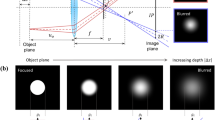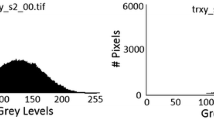Abstract
A novel, accurate and simple stereo particle image velocimetry (SPIV) technique utilising three cameras is presented. The key feature of the new technique is that there is no need of a separate calibration phase. The calibration data are measured concurrently with the PIV data by a third paraxial camera. This has the benefit of improving ease of use and reducing the time taken to obtain data. This third camera also provides useful velocity information, considerably improving the accuracy of the resolved 3D vectors. The additional redundancy provided by this third perspective in the stereo reconstruction equations suggests a least-squares approach to their solution. The least-squares process further improves the utility of the technique by means of the reconstruction residual. Detailed error analysis shows that this residual is an accurate predictor of resolved vector errors. The new technique is rigorously validated using both pure translation and rotation test cases. However, while this kind of validation is standard, it is shown that such validation is substantially flawed. The case of the well-known confined vortex breakdown flow is offered as an alternative validation. This flow is readily evaluated using CFD methods, allowing a detailed comparison of the data and evaluation of PIV errors in their entirety for this technique.














Similar content being viewed by others
References
Arroyo M, Greated C (1991) Stereoscopic particle image velocimetry. Meas Sci Technol 2:1181–1186
Chen J, Katz J (2005) Elimination of peak-locking error in PIV analysis using the correlation mapping method. Meas Sci Technol 16:1605–1618
Dusting J, Sheridan J, Hourigan K (2006) A fluid dynamics approach to bioreactor design for cell and tissue culture. Biotechnol Bioeng 94:1196–1208
Escudier M (1984) Observations of the flow produced in a cylindrical container by a rotating endwall. Exp Fluids 2:189–196
Fouras A, Soria J (1998) Accurate out-of-plane vorticity calculation from in-plane velocity vector field data. Exp Fluids 25:409–430
Fouras A, Dusting J, Hourigan K (2007) A simple calibration technique for stereoscopic particle image velocimetry. Exp Fluids 42:799–810
Hori T, Sakakibara J (2004) High-speed scanning stereoscopic PIV for 3d vorticity measurement in liquids. Meas Sci Technol 15:1067–1078
Lawson N, Wu J (1997) Three-dimensional particle image velocimetry: experimental error analysis of a digital angular stereoscopic system. Meas Sci Technol 8:1455–1464
Lindken R (2006) Stereoscopic micro particle image velocimetry. Exp Fluids 41:161–171
Lopez J (1990) Axisymmetrical vortex breakdown. Part 1. Confined swirling flow. J Fluid Mech 221:533–552
Meinhart CD, Werely ST, Santiago JS (2000) A PIV algorithm for estimating time-avergaed velocity fields. J Fluids Eng 122:285–289
Meunier P, Leweke T (2003) Analysis and minimization of errors due to high gradients in particle image velocimetry. Exp Fluids 35:408–421
Perret L, Braud P, Fourment C, David L, Delville J (2006) 3-Component acceleration field measurement by dual-time stereoscopic particle image velocimetry. Exp Fluids 40:813–824
Prasad A (2000) Stereoscopic particle image velocimetry. Exp Fluids 29:103–116
Prasad A, Adrian R (1993) Stereoscopic particle image velocimetry applied to liquid flows. Exp Fluids 15:49–60
Press WH, Flannery BP, Teukolsky SA, Vetterling WT (1992) Numerical recipes in C: the art of scientific computing, 2nd edn. Cambridge University Press, Cambridge
Raffel M, Willert CE, Kompenhans J (1998) Particle image velocimetry: a practical guide. Springer, Berlin
Scarano F, David L, Bsibsi M, Calluaud D (2005) S-PIV comparative assessment: image dewarping + misalignment correction and pinhole + geometric back projection. Exp Fluids 39:257–266
Schroder A, Kompenhans J (2004) Investigation of a turbulent spot using multi-plane stereo particle image velocimetry. Exp Fluids 36:82–90
Soloff SM, Adrian RJ, Liu ZC (1997) Distortion compensation for generalized stereoscopic particle image velocimetry. Meas Sci Technol 8:1441–1454
Sørensen J, Christensen E (1995) Direct numerical simulation of rotating fluid-flow in a closed cylinder. Phys Fluids 7(4):764–778
Sørensen JN, Loc TP (1989) High-order axisymmetric Navier–Stokes code: description and evaluation of boundary conditions. Int J Num Methods Fluids 9:1517–1537
Spohn A, Mory M, Hopfinger E (1998) Experiments on vortex breakdown in a confined flow generated by rotating disk. J Fluid Mech 370:73–99
Thompson MC, Hourigan K (2003) The sensitivity of steady vortex breakdown bubbles in confined cylinder flows to rotating lid misalignment. J Fluid Mech 496:129–138
Vogel H (1968) Experimentelle ergebnisse über die laminare strömung in einem zylindrischen gehäuse mit darin rotierender scheibe. Bericht 6, Max–Planck-Institut für Strömungdforschung, Göttingen
Wieneke B (2005) Stereo-PIV using self-calibration on particle images. Exp Fluids 39:267–280
Willert C (1997) Stereoscopic digital particle image velocimetry for application in wind tunnel flows. Meas Sci Technol 8:1465–1479
Acknowledgments
The authors wish to thank Professor Jens Sørensen for his advice, help and the use of his code. DL thanks the Swiss National Science Foundation for their support.
Author information
Authors and Affiliations
Corresponding author
Rights and permissions
About this article
Cite this article
Fouras, A., Lo Jacono, D. & Hourigan, K. Target-free Stereo PIV: a novel technique with inherent error estimation and improved accuracy. Exp Fluids 44, 317–329 (2008). https://doi.org/10.1007/s00348-007-0404-1
Received:
Revised:
Accepted:
Published:
Issue Date:
DOI: https://doi.org/10.1007/s00348-007-0404-1




